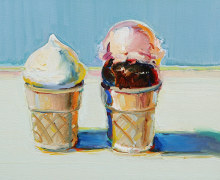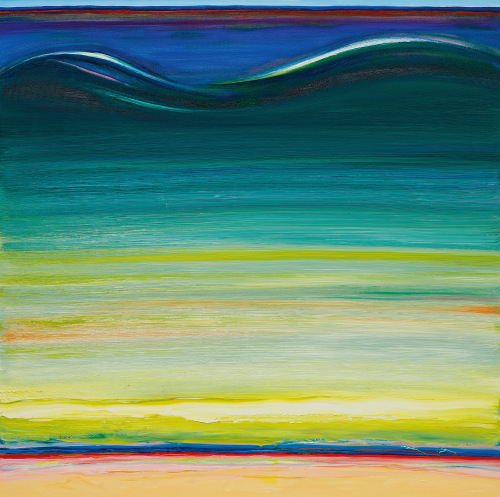

The late painter Wayne Thiebaud’s sun-splashed perspective on life’s simpler, happier moments is filling Acquavella Galleries in New York through mid-June.
The iconic, lushly painted images of ice-cream cones, sandwiches, beach shacks, and ocean views—which Thiebaud painted throughout his lifetime—will make visitors put their worries at the door for a few moments as they bask in his optimism. It’s the first retrospective of the artist’s work in New York since he died at age 101 in 2021.
“We’re trying to keep Wayne and his work relevant and out in the world,” says Eleanor Acquavella, a third-generation co-owner of the gallery.
“Wayne Thiebaud: Summer Days,” which opened at the Upper East Side Manhattan gallery on Friday, includes more than 50 paintings spanning the breadth of the artist’s career, from 1959 to 2021. The theme, proposed by the Wayne Thiebaud Foundation—which is run by the artist’s son, Matt Bult, and his wife, Maria—was selected “because it’s happy and Wayne loved the summer and has all these fond memories of the beach with his family,” Acquavella says.
The paintings reflect Thiebaud’s bright disposition as Acquavella came to know him over the last decade of his life, when the gallery began to represent the artist in New York. She recalls traveling to Sacramento with curator John Wilmerding in 2011, and meeting Thiebaud and his now late wife, Betty Jean (a long-time subject), and being struck by how “warm and easygoing and excited” they were for the New York retrospective the gallery was planning for 2012. The artist hadn’t had a show in the city since his gallerist of more than 40 years, Allan Stone, died in 2006.
That first Acquavella show, organized by Wilmerding into subjects such as food pictures, portraits, landscapes, and objects, included several loans from major museums in addition to works from Thiebaud’s personal collection. The exhibition also spanned from the early days of the artist’s career through recently created works at the time.
Though some paintings included in “Summer Days,” will be for sale, most are either on loan from the foundation, museums, or private collectors, including the watercolor-on-paper Untitled (Six Soda Pops), 1985, and the oil-on-board Untitled (Candy Apples), both in the collection of Matt and Maria Bult.
“Together they provide a sunlit peek into this artist’s world of amusements and proclaim his homespun, fearless interest in themes that others might consider too mundane for consideration,” curator and art historian Steven Nash wrote in a catalog essay for the show. “For Wayne, it was through these everyday familiar subjects that he was able to capture the kaleidoscope of American life.”
The themes of Thiebaud’s work may have come from everyday life, but his work was “bolstered by strict compositional schemes, ringing clarity, and undercurrents of emotions such as desire and nostalgia,” wrote Nash, who knew the artist well.
They also employed formal modes of painting, including the exploration of composition, perspective, and abstraction within the everyday. Nash’s essay explains how Thiebaud’s early work, Candy Counter, 1962, may have appeared to simply offer up a treat-filled case, but it “is in fact a complex dialogue of abstract and realistic forms, spatial compressions, and attraction versus obstruction.”
Thiebaud also worked on many of his paintings over several years. He began Food Bowls in 1992 and finished it in 2005, for instance, Nash wrote.
ncluded in the exhibition, on loan from a private collector, is Coastal (Drawing for California Arts Plate), circa 1993, which was the preparatory work for what became a special license plate. The final plate, featuring a beach scene with palm trees alongside the ocean and a setting sun, reverses and simplifies elements in the original, and is Thiebaud’s “most widely exhibited artwork,” Mary Okin, who recently wrote her PhD dissertation on Thiebaud, said in a separate catalog essay.
The plate continues to be sold to raise funds for public arts education in the state, a cause important to Thiebaud whose own education was publicly funded, Okin said.
“A lot of people don’t know that he did the design for that,” Acquavella says.
Among the gallerist’s many memories of working with Thiebaud was the letters he would handwrite in pencil in “beautiful cursive,” with drawings in the margins, offering simple “thank yous” or expressions of excitement about an upcoming show. Believing her own handwritten missives paled in comparison, Acquavella says she responded with typewritten notes, and later emails that were printed and given to him.
“But I was still the lucky recipient of these amazing handwritten letters of which I keep in a file and are very dear to me,” Acquavella says. “He was just a very kind and gentlemanly and appreciative guy who just never took anything for granted.”